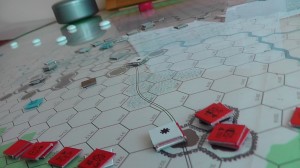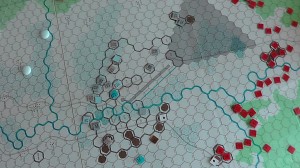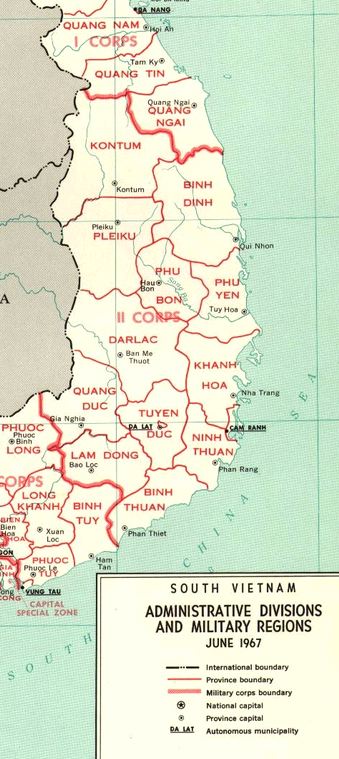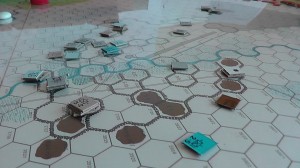Conflict in South-East Asia – the Tonkin and Vietnam wars
The battle of Dien Bien Phu
In order to cut the supply lines o the Viet Minh in North-West Tonkin into Laos, an ally of France, the French decided to draw the Viet Minh into a decisive battle in the valley of Dien Bien Phu.
However, due to incorrect intelligence and serious issues with supply (a French plane could barely make the return trip from the Delta in one go), the French were soon surrounded by heavy artillery and found themselves vastly outnumbered by a determined enemy that no only possessed heavy weapons, but went so far as to dig tunnels and blow up whole strongpoints held by the French in the valley. The battlefield was compared to the trenches in WWI, with the French being “dug in” while they were being shelled by an often invisible enemy from the surrounding mountains.
As the supplies came in less and less frequently (due to anti-aircraft weapons on the side of the Viet Minh, assignments of planes to other areas and bad weather), desertions of locally recruited troops, the French were finally overrun and the battle was lost. Although it was just one battle and the objective not the most strategic, it practically ended the French occupation. On May 8th, the day after the French surrender, a peace conference began in Geneva, as its result, Vietnam was split into two parts: the Communist North and the French-backed South.
The last French troops left Vietnam in 1956.
Citadel – The battle of Dien Bien Phu – Narrative and gameplay
The game Citadel, by Game Designers’ Workshop (copyright 1977) tells the story of this battle. The different stages of the siege are told in 8 scenarios which can be played solo or by two players. The game itself is a tactical-operational hybrid played on company/battalion level. Each scenario runs through several turn, each lasting one day.
In order to depict the whole and very rich story of this battle, the game comes with a basic rule-set, which mainly deals with the tactical aspects of the game (movement and melee as well as the all-important heavy artillery that eventually gave the Viet Minh the upper hand). These rules should be expanded by supply rules (otherwise, the Viet Minh are simply too strong if they have unrestricted access to ammunition supplies). Other advanced rules / errata rules include operational aspects such as culling and repair of aircraft, absentee pilots, different deployments of planes, strategic and tactical bombing by the French, tunnel building etc.
The game features some very simple but effective and easy-to-use artillery and melee mechanics (DRM by distance, terrain, type of artillery, phase) as well as the very interesting of movement through vulnerability points. Instead of movement points, which are spent depending on terrain type, each unit can theoretically move indefinitely. But following particular rules, certain hexes constitute “vulnerability points” which cause the unit(s) to pause and give the enemy the chance of opportunity fire. While this is a neat mechanic, it becomes quite tedious when a unit moves from one vulnerability point into the next. If the artillery is arrayed smartly, this can turn into several rounds of opportunity fire, which in my games led to a virtual dice fest.
In addition, different types of artillery can fire in different phases of the turn, which leads again to quite a lot of die-rolling and in one game meant that after the first turn, the objectives had been achieved and the French could be picked off one by one just using the indirect and direct fire phases without even going into melee.


Given the fact that the game could not decide whether it wanted to be a tactical game or an operational game, you really need to use the advanced rules in order to make the game more interesting (don’t get me wrong, I do not have an issue with unbalanced games, Caesar Conquest of Gaul is a case in point, but if I can tell from the very beginning what is going to happen and do not see that I have any chance of making a difference as the “losing” side and am bereft of meaningful decisions, then I will actually not play). However, the advanced rules (like the whole rule book badly written) add so much operational chrome to the tactical side of the game and so many more dice-rolling “opportunities” that I did not last long.
I really think this battle is a fascinating topic for a tactical (and perhaps even an operational) game. However, the hybrid treatment it received here was not the great experience I had hoped for. That being said, I will return to this game. I have been thinking about it extensively and have some ideas as to how it can be streamlined a little to make it less cumbersome to play while still retaining its balance.
Sources:
http://en.wikipedia.org/wiki/Battle_of_Dien_Bien_Phu


Thanks for the your write-up. I have been wondering about this game and was looking for a review like yours. I appreciate your candor, as I always like to hear the bad as well as the good. It does sound like an interesting game. Please update us after your streamlining.
Mark D.
The Boardgaming Life
Interesting, I consider this one of the better games from the decade when it came out. My friends and I returned to it repeatedly and even when playing another game (we did quite a few large multiplayer games or “blind” games), this would usually be on the side. Of course, the issue might be that there is simply no way for the French to “win”, but must simply sell themselves as dearly as possible in an attempt to wreck the Viets.
Throw in some what-ifs, since it is what it is for. Abandon Isabelle to the Thais and use up your non-FFL troops as the initial counter assault troops. As they get shot up and morale drops, relegate them to absorbing losses from arty. It is a most devious game to try to get the maximum from the French and do the minimum with the Viet troops while maximizing the artillery.